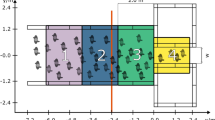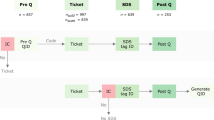Abstract
In the present study experimenters attempted to make eye contact with commuters as they approached an express train linking city and suburb and, 20 minutes later, as commuters left the same train. During both the morning rush from suburb to city and the evening rush from city to suburb, commuters were less willing to meet an experimenter's eye at the city train station than at the suburban station. These results support the hypothesis that reduced eye contact with strangers in the city is a short-term adaptation to interpersonal overload in the city. Most generally the results indicate a convergence of laboratory and field data toward the conclusion that crowding effects on behavior are best understood as adaptation to interpersonal overload.
Similar content being viewed by others
References
Baron, R. M., Mandel, D. F., Adams, C. A., & Griffen, L. M. Effects of social density in university residential environments.Journal of Personality and Social Psychology, 1976,34, 434–446.
Baum, A., & Greenberg, C. I. Waiting for a crowd: The behavioral and perceptual effects of anticipated crowding.Journal of Personality and Social Psychology, 1975,32, 671–679.
Baum, A., & Koman, S. Differential response to anticipated crowding: Psychological effects of social and spatial density.Journal of Personality and Social Psychology, 1976,34, 526–536.
Freedman, J.Crowding and behavior. San Francisco: Freeman, 1975.
Freedman, J., Klevansky, S., & Ehrlich, P. The effect of crowding on human task performance.Journal of Applied Social Psychology, 1971,1, 7–25.
Griffitt, W., & Veitch, R. Hot and crowded: Influences of population density and temperature on interpersonal affective behavior.Journal of Personality and Social Psychology, 1971,17, 92–98.
Hutt, C., & Vaisey, M. J. Differential effects of group density on social behavior.Nature, 1966,209, 1371–72.
McCauley, C., & Taylor, J. A test of the urban overload hypothesis.Environmental Psychology and Nonverbal Behavior, 1976,1, 41–55.
McGrew, W. C.An Ethological Study of Children's Behavior. New York: Academic Press, 1972.
Milgram, S. The experience of living in cities.Science, 1970,167, 1461–1468.
Miller, J. G. Sensory overloading. In B. E. Flaherty (Ed.),Psycho-physiological Aspects of of Space Flight. New York: Columbia University Press, 1961.
National Commission on the Causes and Prevention of Violence.To Establish Justice, to Insure Domestic Tranquility. New York: Praeger, 1970.
Ross, M., Layton, B., Erickson, B., & Schopler, J. Affect, facial regard, and reactions to crowding.Journal of Personality and Social Psychology, 1973,28, 68–76.
Simmel, G.The Sociology of Georg Simmel. New York: Macmillan, 1950. (English translation of G. Simmel,Die Grossstadte und des Geistesleben Die Grossstadt. Dresden: Jansch, 1903.)
Sundstrom, E. An experimental study of crowding: Effects of room size, intrusion, and goal blocking on nonverbal behavior, self-disclosure, and self-reported stress.Journal of Personality and Social Psychology, 1975,32, 645–654.
Valins, S., & Baum, A. Residential group size, social interaction, and crowding.Environment and Behavior, 1973,5, 421–439.
Worchel, S., & Teddlie, C. The experience of crowding: A two-factor theory.Journal of Personality and Social Psychology, 1976,34, 30–40.
Reference Note
McCauley, C., & Newman, J. Eye contact with strangers in city, suburb, and small town.Environment and Behavior, in press.
Author information
Authors and Affiliations
Rights and permissions
About this article
Cite this article
McCauley, C., Coleman, G. & De Fusco, P. Commuters' eye contact with strangers in city and suburban train stations: Evidence of short-term adaptation to interpersonal overload in the city. J Nonverbal Behav 2, 215–225 (1978). https://doi.org/10.1007/BF01173770
Issue Date:
DOI: https://doi.org/10.1007/BF01173770




